This tutorial series will teach you the basics of building an ASP.NET MVC 5 Web application using Visual Studio 2013 and Visual Basic. A Visual Studio Express For Web project with VB source code is available to accompany this series which you can download.
The tutorial series comprises 11 sections in total. They cover the basics of web development using the ASP.NET MVC framework and the Entity Framework for data access. They are intended to be followed sequentially as each section builds on the knowledge imparted in the previous sections. The navigation path through the series is as follows:
- Getting Started
- Adding a Controller
- Adding a View
- Adding a Model
- Creating a Connection String and Working with SQL Server LocalDB
- Accessing Your Model's Data from a Controller
- Examining the Edit Methods and Edit View
- Adding Search
- Adding a New Field
- Adding Validation
- Examining the Details and Delete Methods
6. Accessing Your Model's Data from a Controller
In this section, you'll create a new MoviesController class and write code that retrieves movie data and displays it in the browser using a view template.
Build the application (press Ctrl+Shift+B, or select 'Build MvcMovie' from the Debug menu, or right click on the project name in Solution Explorer and select 'Build') before going on to the next step. If you don't build the application, you'll get an error when adding a controller.
In Solution Explorer, right-click the Controllers folder and then click Add, then Controller.
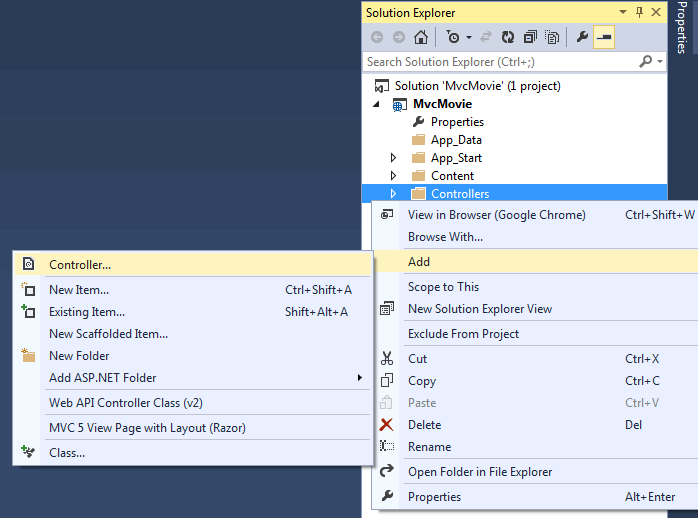
In the Add Scaffold dialog box, click MVC 5 Controller with views, using Entity Framework, and then click Add.
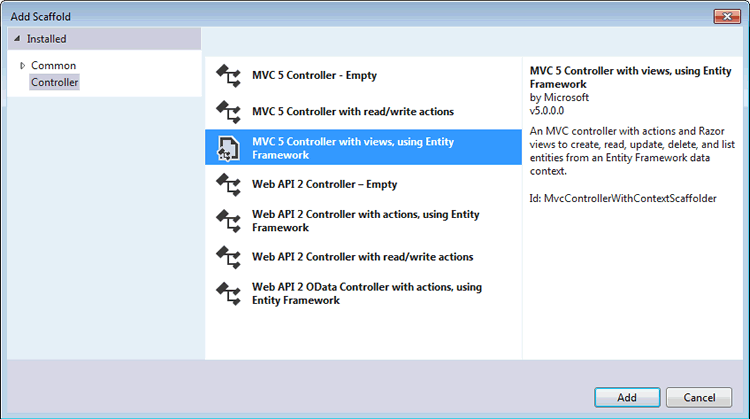
- For the Controller name enter MoviesController.
- Select Movie (MvcMovie.Models) for the Model class.
- Select MovieDBContext (MvcMovie.Models) for the Data context class.
The image below shows the completed dialog.
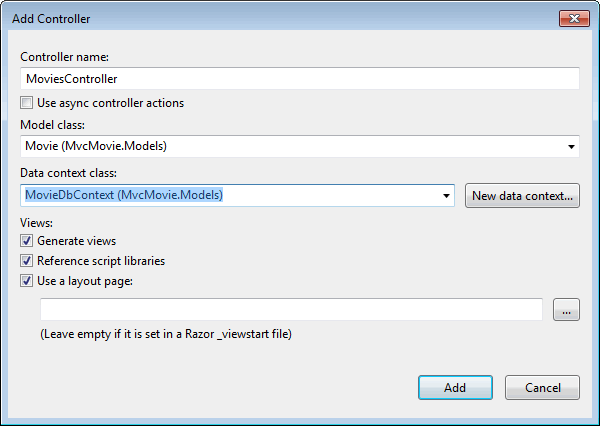
Click Add. (If you get an error, you probably didn't build the application before starting adding the controller.) Visual Studio creates the following files and folders:
- A MoviesController.vb file in the Controllers folder.
- A Views\Movies folder.
- Create.vbhtml, Delete.vbhtml, Details.vbhtml, Edit.vbhtml, and Index.vbhtml in the new Views\Movies folder.
Visual Studio automatically created the CRUD (Create, Read, Update, and Delete) action methods and views for you (the automatic creation of CRUD action methods and views is known as scaffolding). You now have a fully functional web application that lets you create, list, edit, and delete movie entries.
Run the application and click on the MVC Movie link (or browse to the Movies controller by appending /Movies to the URL in the address bar of your browser). Because the application relies on the default routing (defined in the App_Start\RouteConfig.vb file), the browser request http://localhost:xxxxx/Movies is routed to the default Index action method of the Movies controller. In other words, the browser request http://localhost:xxxxx/Movies is effectively the same as the browser request http://localhost:xxxxx/Movies/Index. The result is an empty list of movies, because you haven't added any yet.
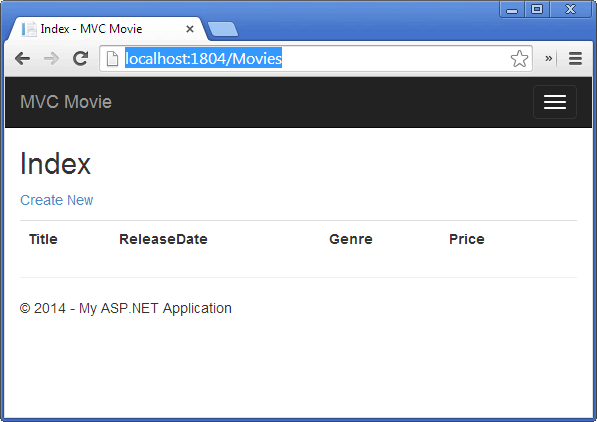
Creating a Movie
Select the Create New link. Enter some details about a movie and then click the Create button.
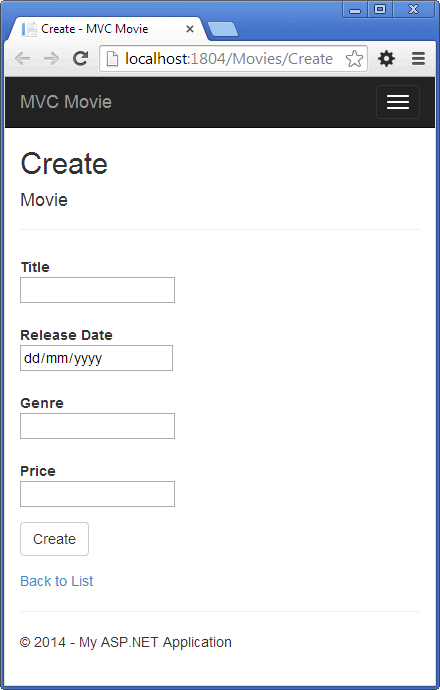
Note: Depending on your regional settings, you may not be able to enter decimal points or commas in the Price field. To support jQuery validation for non-English locales that use a comma (",") for a decimal point, and non US-English date formats, you must include globalize.js and your specific cultures/globalize.cultures.js file (from https://github.com/jquery/globalize ) and JavaScript to use Globalize.parseFloat. I'll show how to do this in the next tutorial. For now, just enter whole numbers like 10.
Clicking the Create button causes the form to be posted to the server, where the movie information is saved to the database. You're then redirected to the /Movies URL, where you can see the newly created movie in the listing.
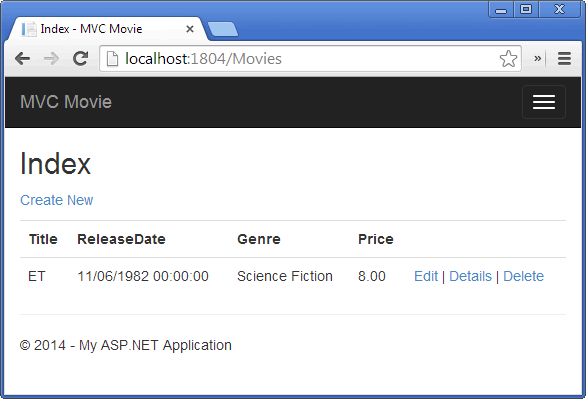
Create a couple more movie entries. Try the Edit, Details, and Delete links, which are all functional.
Examining the Generated Code
Open the Controllers\MoviesController.vb file and examine the generated Index method. A portion of the movie controller with the Index method is shown below.
Namespace MvcMovie Public Class MoviesController Inherits System.Web.Mvc.Controller Private db As New MovieDbContext ' GET: /Movies/ Function Index() As ActionResult Return View(db.Movies.ToList()) End Function
A request to the Movies controller returns all the entries in the Movies table and then passes the results to the Index view. The following line from the MoviesController class instantiates a movie database context, as described previously. You can use the movie database context to query, edit, and delete movies.
Private db As New MovieDbContext
Strongly Typed Models and the @ModelType Keyword
Earlier in this tutorial, you saw how a controller can pass data or objects to a view template using the ViewBag object. The ViewBag is a dynamic object that provides a convenient late-bound way to pass information to a view.
MVC also provides the ability to pass strongly typed objects to a view template. This strongly typed approach enables better compile-time checking of your code and richer IntelliSense in the Visual Studio editor. The scaffolding mechanism in Visual Studio used this approach (that is, passing a strongly typed model) with the MoviesController class and view templates when it created the methods and views.
In the Controllers\MoviesController.vb file examine the generated Details method. The Details method is shown below.
' GET: /Movies/Details/5 Function Details(ByVal id As Integer?) As ActionResult If IsNothing(id) Then Return New HttpStatusCodeResult(HttpStatusCode.BadRequest) End If Dim movie As Movie = db.Movies.Find(id) If IsNothing(movie) Then Return HttpNotFound() End If Return View(movie) End Function
The id parameter is generally passed as route data, for example http://localhost:1234/movies/details/1 will set the controller to the movie controller, the action to details and the id to 1. You could also pass in the id with a query string as follows:
http://localhost:1234/movies/details?id=1
If a Movie is found, an instance of the Movie model is passed to the Details view:
Return View(movie)
Examine the contents of the Views\Movies\Details.vbhtml file:
@ModelType MvcMovie.Models.Movie @Code ViewData("Title") = "Details" End Code <h2>Details</h2> <div> <h4>Movie</h4> <hr /> <dl class="dl-horizontal"> <dt> @Html.DisplayNameFor(Function(model) model.Title) </dt> @*Markup omitted for clarity*@ </dl> </div> <p> @Html.ActionLink("Edit", "Edit", New With { .id = Model.ID }) | @Html.ActionLink("Back to List", "Index") </p>
By including a @ModelType statement at the top of the view template file, you can specify the type of object that the view expects. When you created the movie controller, Visual Studio automatically included the following @ModelType statement at the top of the Details.vbhtml file based on the Model class you selected when adding the controller:
@ModelType MvcMovie.Models.Movie
This @ModelType directive allows you to access the movie that the controller passed to the view by using a Model object that's strongly typed. For example, in the Details.vbhtml template, the code passes each movie field to the DisplayNameFor and DisplayFor HTML Helpers with the strongly typed Model object. The Create and Edit methods and view templates also pass a movie model object.
Examine the Index.vbhtml view template and the Index method in the MoviesController.vb file. Notice how the code creates a List object when it calls the View helper method in the Index action method. The code then passes this Movies list from the Index action method to the view:
Function Index() As ActionResult Return View(db.Movies.ToList()) End Function
When you created the movie controller, Visual Studio automatically included the following @ModelType statement at the top of the Index.cshtml file:
@ModelType IEnumerable(Of MvcMovie.Models.Movie)
This @ModelType directive allows you to access the list of movies that the controller passed to the view by using a Model object that's strongly typed. For example, in the Index.vbhtml template, the code loops through the movies by doing a For Each statement over the strongly typed Model object:
@For Each item In Model @<tr> <td> @Html.DisplayFor(Function(modelItem) item.Title) </td> <td> @Html.DisplayFor(Function(modelItem) item.ReleaseDate) </td> <td> @Html.DisplayFor(Function(modelItem) item.Genre) </td> <td> @Html.DisplayFor(Function(modelItem) item.Price) </td> <td> @Html.ActionLink("Edit", "Edit", New With {.id = item.ID }) | @Html.ActionLink("Details", "Details", New With {.id = item.ID }) | @Html.ActionLink("Delete", "Delete", New With {.id = item.ID }) </td> </tr> Next
Because the Model object is strongly typed (as an IEnumerable<Movie> object in this example), each item object in the loop is typed as Movie. Among other benefits, this means that you get compile-time checking of the code and full IntelliSense support in the code editor:
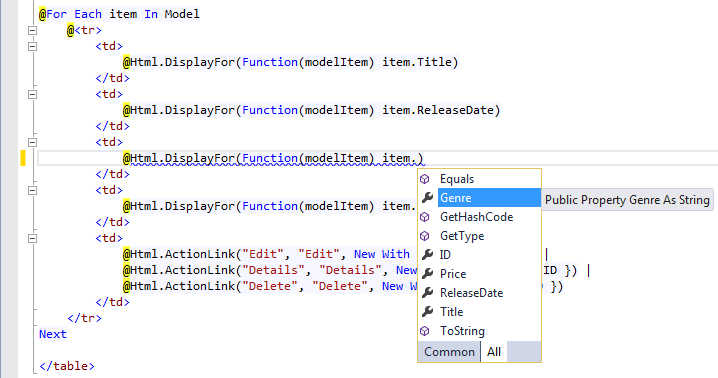
Working with SQL Server LocalDB
Entity Framework Code First detected that the database connection string that was provided pointed to a Movies database that didn’t exist yet, so Code First created the database automatically. You can verify that it's been created by looking in the App_Data folder. If you don't see the Movies.mdf file, click the Show All Files button in the Solution Explorer toolbar, click the Refresh button, and then expand the App_Data folder.
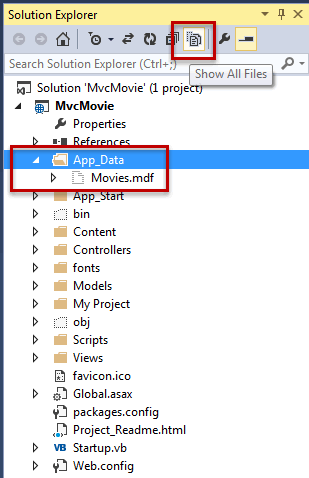
Double-click Movies.mdf to open SERVER EXPLORER, then expand the Tables folder to see the Movies table. Note the key icon next to ID. By default, EF will make a property named ID the primary key. For more information on EF and MVC, see this tutorial series on MVC and EF.
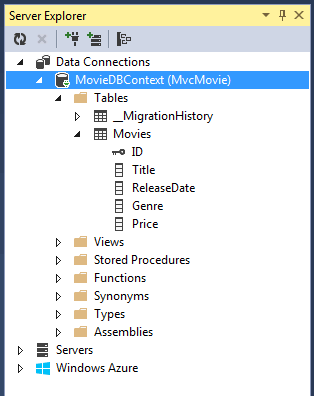
Right-click the Movies table and select Show Table Data to see the data you created.
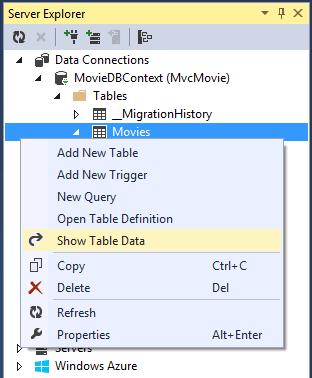
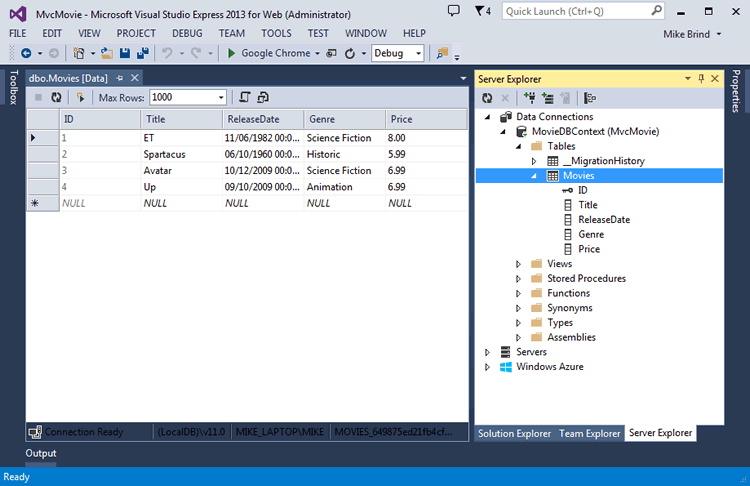
Right-click the Movies table and select Open Table Definition to see the table structure that Entity Framework Code First created for you.
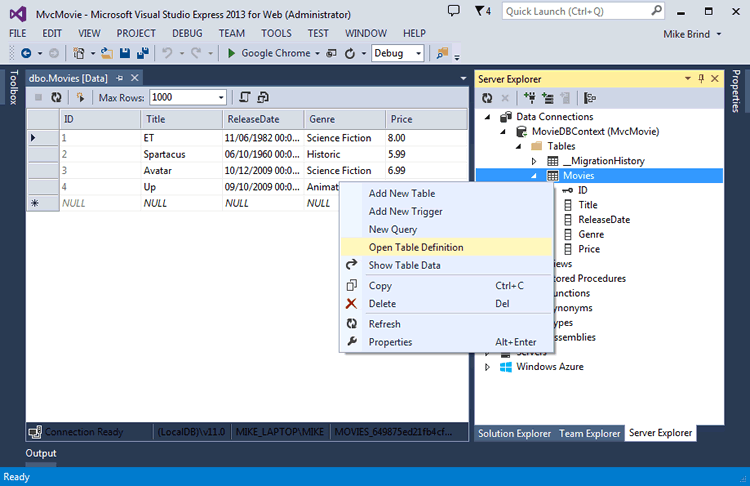
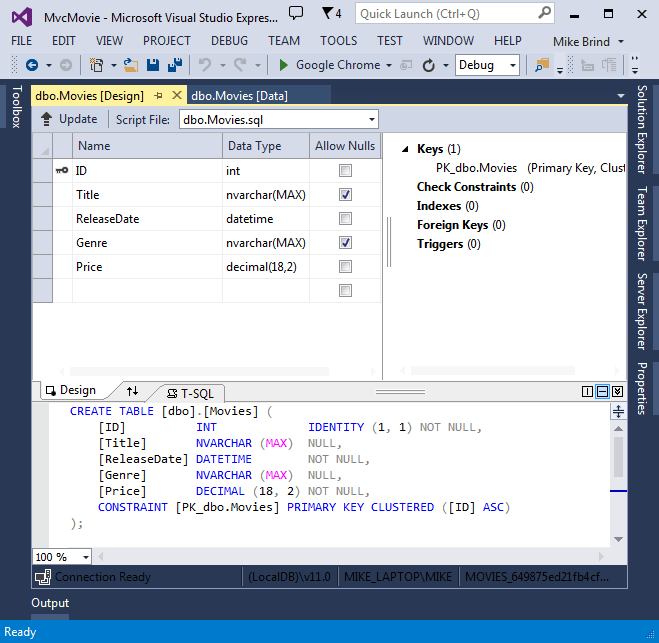
Notice how the schema of the Movies table maps to the Movie class you created earlier. Entity Framework Code First automatically created this schema for you based on your Movie class.
When you're finished, close the connection by right clicking MovieDBContext and selecting Close Connection. (If you don't close the connection, you might get an error the next time you run the project).
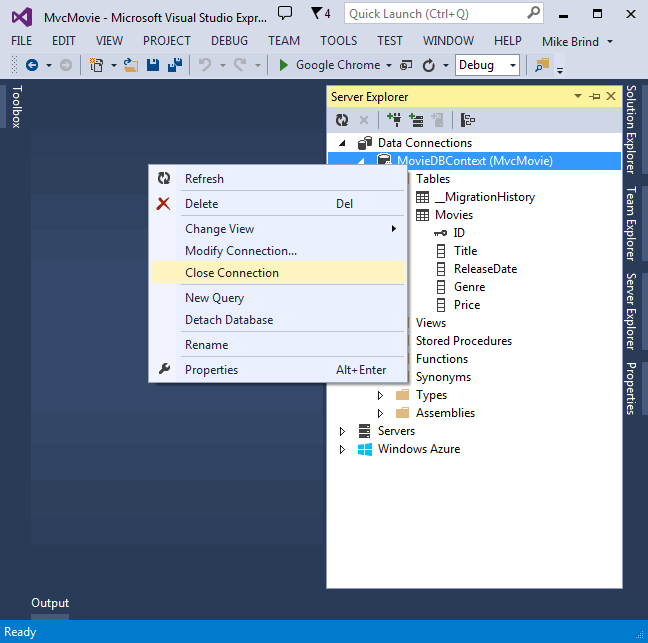
You now have a database and pages to display, edit, update and delete data. In the next tutorial, we'll examine the rest of the scaffolded code and add a SearchIndex method and a SearchIndex view that lets you search for movies in this database. For more information on using Entity Framework with MVC, see Creating an Entity Framework Data Model for an ASP.NET MVC Application.
